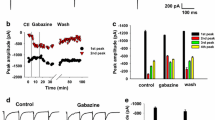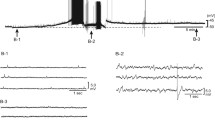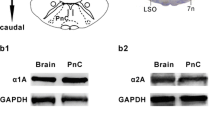Abstract
Somatosensory afferent transmission strength is controlled by several presynaptic mechanisms that reduce transmitter release at the spinal cord level. We focused this investigation on the role of α-adrenoceptors in modulating sensory transmission in low-threshold myelinated afferents and in pathways mediating primary afferent depolarization (PAD) of neonatal mouse spinal cord. We hypothesized that the activation of α-adrenoceptors depresses low threshold-evoked synaptic transmission and inhibits pathways mediating PAD. Extracellular field potentials (EFPs) recorded in the deep dorsal horn assessed adrenergic modulation of population monosynaptic transmission, while dorsal root potentials (DRPs) recorded at root entry zone assessed adrenergic modulation of PAD. We found that noradrenaline (NA) and the α1-adrenoceptor agonists phenylephrine and cirazoline depressed synaptic transmission (by 15, 14 and 22%, respectively). DRPs were also depressed by NA, phenylephrine and cirazoline (by 62, 30, and 64%, respectively), and by the α2-adrenoceptor agonist clonidine, although to a lower extent (20%). We conclude that NA depresses monosynaptic transmission of myelinated afferents onto deep dorsal horn neurons via α1-adrenoceptors and inhibits interneuronal pathways mediating PAD through the activation of α1- and α2-adrenoceptors. The functional significance of these modulatory actions in shaping cutaneous and muscle sensory information during motor behaviors requires further study.






Similar content being viewed by others
References
Barker JL, Nicoll RA (1972) Gamma-aminobutyric acid: role in primary afferent depolarization. Science 173:1043–1045. https://doi.org/10.1126/science.176.4038.1043
Brink E, Jankowska E, Skoog B (1984) Convergence onto interneurons subserving primary afferent depolarization of group I afferents. J Neurophysiol 51:432–449. https://doi.org/10.1152/jn.1984.51.3.432
Buckner SA, Milicic I, Daza AV, Meyer MD, Altenbach RJ, Williams M, Sullivan JP, Brioni JD (2002) ABT-866, a novel alpha(1A)-adrenoceptor agonist with antagonist properties at the alpha(1B)- and alpha(1D)-adrenoceptor subtypes. Eur J Pharmacol 449:159–165. https://doi.org/10.1016/s0014-2999(02)01976-3
Czermak C, Lehofer M, Liebmann PM, Traynor J (2006) [35S]GTPgammaS binding at the human dopamine D4 receptor variants hD4.2, hD4.4 and hD4.7 following stimulation by dopamine, epinephrine and norepinephrine. Eur J Pharmacol 531:20–24. https://doi.org/10.1016/j.ejphar.2005.11.063
Day HE, Campeau S, Watson SJ Jr, Akil H (1997) Distribution of alpha 1a-, alpha 1b- and alpha 1d-adrenergic receptor mRNA in the rat brain and spinal cord. J Chem Neuroanato 13:115–139
Dawson LF, Phillips JK, Finch PM, Inglis JJ, Drummond PD (2011) Expression of α1-adrenoceptors on peripheral nociceptive neurons. Neuroscience 175:300–314. https://doi.org/10.1016/j.neuroscience.2010.11.064
Drummond PD, Drummond ES, Dawson LF, Mitchell V, Finch PM, Vaughan CW, Phillips JK (2014) Upregulation of α1-adrenoceptors on cutaneous nerve fiber after partial sciatic ligation in complex regional pain syndrome type II. Pain 155:606–616. https://doi.org/10.1016/j.pain.2013.12.021
García-Ramírez DL, Calvo JR, Hochman S, Quevedo JN (2014) Serotonin, dopamine and noradrenaline adjust actions of myelinated afferents via modulation of presynaptic inhibition in the mouse spinal cord. PLoS ONE 9:e89999. https://doi.org/10.1371/journal.pone.008999
Garraway SM, Hochman S (2001a) Serotonin increases the incidence of primary afferent-evoked long-term depression in rat deep dorsal horn neurons. J Neurophysiol 85:1864–1872. https://doi.org/10.1152/jn.2001.85.5.1864
Garraway SM, Hochman S (2001b) Modulatory actions of serotonin, norepinephrine, dopamine, and acetylcholine in spinal cord deep dorsal horn neurons. J Neurophysiol 86:2183–2194. https://doi.org/10.1152/jn.2001.86.5.2183
Gassner M, Ruscheweyh R, Sandkühler J (2009) Direct excitation of spinal GABAergic interneurons by noradrenaline. Pain 145:204–210. https://doi.org/10.1016/j.pain.2009.06.021
Hammar I, Jankowska E (2003) Modulatory effects of alpha1-, alpha2-, and beta –receptor agonists on feline spinal interneurons with monosynaptic input from group I muscle afferents. J Neurosci 23:332–338
Harvey PJ, Li X, Bennett DJ (2006) Endogenous monoamine receptor activation is essential for enabling persistent sodium currents and repetitive firing in rat spinal motoneurons. J Neurophysiol 96:1171–1186. https://doi.org/10.1152/jn.00341.2006
Jahr CE, Yoshioka K (1986) Ia afferent excitation of motoneurones in the in vitro new-born rat spinal cord is selectively antagonized by kynurenate. J Physiol 370:515–530. https://doi.org/10.1113/jphysiol.1986.sp015948
Jessell TM, Yoshioka K, Jahr CE (1986) Amino acid receptor-mediated transmission at primary afferent synapses in rat spinal cord. J Exp Biol 124:239–258
Kawasaki Y, Kumamoto E, Furue H, Yoshimura M (2003) Alpha 2 adrenoceptor-mediated presynaptic inhibition of primary afferent glutamatergic transmission in rat substantia gelatinosa neurons. Anesthesiology 98:682–689. https://doi.org/10.1097/00000542-200303000-00016
Krnjevic K, Lamour Y, MacDonald JF, Nistri A (1978) Intracellular actions of monoamine transmitters. Can J Physiol Pharmacol 56:896–900. https://doi.org/10.1139/y78-142
Lu Y, Doroshenko M, Lauzadis J, Kanjiya MP, Rebecchi MJ, Kaczocha M, Puopolo M (2018) Presynaptic inhibition of primary nociceptive signals to dorsal horn lamina I neurons by dopamine. J Neurosci 38:8809–8821. https://doi.org/10.1523/JNEUROSCI.0323-18.2018
Machacek DW, Garraway SM, Shay BL, Hochman S (2001) Serotonin 5-HT(2) receptor activation induces a long-lasting amplification of spinal reflex actions in the rat. J Physiol 537:201–207. https://doi.org/10.1111/j.1469-7793.2001.0201k.x
Minneman KP, Theroux TL, Hollinger S, Han C, Esbenshade TA (1994) Selectivity of agonists for cloned alpha 1-adrenergic receptor subtypes. Mol Pharmacol 46:929–936
Newman-Tancredi A, Audinot-Bouchez V, Gobert A, Millan MJ (1997) Noradrenaline and adrenaline are high affinity agonist at dopamine D4 receptors. Eur J Pharmacol 319:379–383. https://doi.org/10.1016/s0014-2999(96)00985-5
Nicholson R, Dixon AK, Spanswick D, Lee K (2005) Noradrenergic receptor mRNA expression in adult rat superficial dorsal horn and dorsal root ganglion neurons. Neurosci Lett 380:316–321. https://doi.org/10.1016/j.neulet.2005.01.079
Noga BR, Bras H, Jankowska E (1992) Transmission from group II muscle afferents is depressed by stimulation of locus coeruleus/subcoeruleus, Kölliker-Fuse and raphe nuclei in the cat. Exp Brain Res 88:502–516. https://doi.org/10.1007/bf00228180
O’Neill DJ, Adedoyin A, Alfinto PD, Braya JA, Cosmi S, Deecher DC, Fensome A, Harrison J, Leventhal L, Mann C, McComas CC, Sullivan NR, Spangler TB, Uveges AJ, Trybulski EJ, Whiteside GT, Zhang P (2010) Discovery of novel selective norepinephrine reuptake inhibitors: 4-[3-aryl-2,2-dioxido-2,1,3-benzothiadiazol-1(3H)-yl]-1-(methylamino)butan-2-ols (WYE-103231). J Med Chem 53:4511–4521. https://doi.org/10.1021/jm100053t
Peng YY, Frank E (1989) Activation of GABAB receptors causes presynaptic inhibition at synapses between muscle spindle afferents and motoneurons in the spinal cord of bullfrogs. J Neurosci 9:1502–1515
Pihlavisto M, Sjoholm B, Scheinin M, Wurster S (1998) Modulation of agonist binding to recombinant human alpha2-adrenoceptors by sodium ions. Biochim Biophys Acta 1448:135–146. https://doi.org/10.1016/s0167-4889(98)00118-9
Pinto V, Derkach VA, Safronov BV (2008) Role of TTX-sensitive and TTX-resistant sodium channels in Adelta- and C-fiber conduction and synaptic transmission. J Neurophysiol 99:617–628. https://doi.org/10.1152/jn.00944.2007
Pluteanu F, Ristoiu V, Flonta ML, Reid G (2002) Alpha(1)-adrenoceptor-mediated depolarization and beta-mediated hyperpolarization in cultured rat dorsal root ganglion neurones. Neurosci Lett 329:277–280. https://doi.org/10.1016/s0304-3940(02)00665-1
Rank MM, Murray KC, Stephens MJ, D’Amico J, Gorassini MA, Bennett DJ (2011) Adrenergic receptors modulate motoneuron excitability, sensory synaptic transmission and muscle spasms after chronic spinal cord injury. J Neurophysiol 105:410–422. https://doi.org/10.1152/jn.00775.2010
Rémy-Néris O, Barbeau H, Daniel O, Boiteau F, Bussel B (1999) Effects of intrathecal clonidine injection on spinal reflex and human locomotion in incomplete paraplegic subjects. Exp Brain Res 129:433–440. https://doi.org/10.1007/s002210050910
Riddell JS, Jankowska E, Eide E (1993) Depolarization of group II muscle afferents by stimuli applied in the locus coeruleus and raphe nuclei of the cat. J Physiol 461:723–741. https://doi.org/10.1113/jphysiol.1993.sp019538
Root DH, Hoffman AF, Good CH, Zhang S, Gigante E, Lupica CR, Morales M (2015) Norepinephrine activates dopamine D4 receptors in the rat lateral habenula. J Neurosci 35:360–369. https://doi.org/10.1523/JNEUROSCI.4525-13.2015
Rudomin P, Schmidt RF (1999) Presynaptic inhibition in the vertebrate spinal cord revisited. Exp Brain Res 129:1–37. https://doi.org/10.1007/s002210050933
Russo RE, Delgado-Lezama R, Hounsgaard J (2007) Heterosynaptic modulation of the dorsal root potential in the turtle spinal cord in vitro. Exp Brain Res 177:275–284. https://doi.org/10.1007/s00221-006-0668-3
Salio C, Merighi A, Bardoni R (2017) GABAB receptors-mediated tonic inhibition of glutamate release from Aβ fibers in rat laminae III/IV of the spinal cord dorsal horn. Mol Pain 13:1744806917710041. https://doi.org/10.1177/1744806917710041
Shay BL, Sawchuk M, Machacek DW, Hochman S (2005) Serotonin 5-HT2 receptors induce a long-lasting facilitation of spinal reflexes independent of ionotropic receptor activity. J Neurophysiol 94:2867–2877. https://doi.org/10.1152/jn.00465.2005
Shi TS, Winzer-Sherhan U, Leslie F, Hökfelt T (2000) Distribution and regulation of alpha(2)-adrenoceptors in rat dorsal root ganglia. Pain 84:319–330
Shibata K, Foglar R, Horie K, Obika K, Sakamoto A, Ogawa S, Tsujimoto G (1995) KMD-3213, a novel, potent, alpha 1a-adrenoceptor-selective antagonist: characterization using recombinant human alpha 1-adrenoceptors and native tissues. Mol Pharmacol 48:250–258
Sonohata M, Furue H, Katafuchi T, Yasaka T, Doi A, Kumamoto E, Yoshimura M (2004) Actions of noradrenaline on substantia gelatinosa neurons in the rat spinal cord revealed by in vivo patch recording. J Physiol 555:515–526. https://doi.org/10.1113/jphysiol.2003.054932
Starke K, Göthert M, Kilbinger H (1989) Modulation of neurotransmitter release by presynaptic autoreceptors. Physiol Rev 69:864–989. https://doi.org/10.1152/physrev.1989.69.3.864
Stewart J, Berbeau H, Gauthier S (1991) Modulation of locomotor patterns and spasticity with clonidine in spinal cord injured patients. Can J Neurol Sci 18:321–332. https://doi.org/10.1017/s0317167100031887
Stone LS, Broberger C, Vulchanova L, Wilcox GL, Hökfelt T, Riedl MS, Elde R (1998) Differential distribution of alpha2A and alpha2C adrenergic receptor immunoreactivity in the rat spinal cord. J Neurosci 18:5928–5937
Sullivan AF, Dashwood MR, Dickenson AH (1987) Alpha 2-adrenoceptor modulation of nociception in rat spinal cord: location, effects and interaction with morphine. Eur J Pharmacol 138:169–177. https://doi.org/10.1016/0014-2999(87)90430-4
Tartas M, Morin F, Berrière G, Goillandeau M, Lacaille JC, Cazalets JR, Bertrand SS (2010) Noradrenergic modulation of intrinsic and synaptic properties of lumbar motoneurons in the neonatal rat spinal cord. Front Neural Circuits 8(4):4. https://doi.org/10.3389/neuro.04.004.2010
Turecek J, Jackman SL, Regehr WG (2017) Synaptotagmin 7 confers frequency invariance onto specialized depressing synapsis. Nature 551:503–506. https://doi.org/10.1038/nature24474
Vejsada R, Palecek J, Hník P, Soukup T (1985) Postnatal development of conduction velocity and fiber size in the rat tibial nerve. Int J Dev Neurosci 3:583–595. https://doi.org/10.1016/0736-5748(85)90048-6
Wu LG, Saggau P (1997) Presynaptic inhibition of elicited neurotransmitter release. Trends Neurosci 20:204–212. https://doi.org/10.1016/s0166-2236(96)01015-6
Yuan WX, Chen SR, Chen H, Pan HL (2009) Stimulation of alpha(1)-adrenoceptors reduces glutamatergic synaptic input from primary afferents through GABA(A) receptors and T-type Ca(2+) channels. Neuroscience 158:1616–1624. https://doi.org/10.1016/j.neuroscience.2008.11.022
Zheng Y, Liu P, Bai L, Trimmer JS, Bean BP, Ginty DD (2019) Deep sequencing of somatosensory neurons reveals molecular determinants on intrinsic physiological properties. Neuron 103:598–616. https://doi.org/10.1016/j.neuron.2019.05.039
Zimmerman AL, Kovatsis EM, Pozsgai RY, Tasnim A, Zhang Q, Ginty DD (2019) Distinct modes of presynaptic inhibition of cutaneous afferents and their functions in behavior. Neuron 102:420–434. https://doi.org/10.1016/j.neuron.2019.02.002
Funding
National Institute of Neurological Disorders and Stroke (NS-065949). Consejo Nacional de Ciencia y Tecnología (Conacyt-59873).
Author information
Authors and Affiliations
Contributions
All authors contributed to the conception and design of the study. Material preparation, data collection, and analysis were performed by Elvia Mena-Avila and Jonathan J. Milla-Cruz. The first draft of the manuscript was written by Elvia Mena-Avila and all authors commented on the previous versions of the manuscript. All authors read and approved the final manuscript.
Corresponding author
Ethics declarations
Conflict of interest
The authors declare that they have no conflict of interest.
Additional information
Communicated by Winston D. Byblow.
Publisher's Note
Springer Nature remains neutral with regard to jurisdictional claims in published maps and institutional affiliations.
Rights and permissions
About this article
Cite this article
Mena-Avila, E., Milla-Cruz, J.J., Calvo, J.R. et al. Activation of α-adrenoceptors depresses synaptic transmission of myelinated afferents and inhibits pathways mediating primary afferent depolarization (PAD) in the in vitro mouse spinal cord. Exp Brain Res 238, 1293–1303 (2020). https://doi.org/10.1007/s00221-020-05805-y
Received:
Accepted:
Published:
Issue Date:
DOI: https://doi.org/10.1007/s00221-020-05805-y




